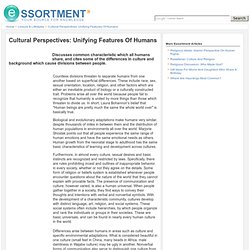

How We Speak Reveals What We Think, with Steven Pinker. Transcript My name is Steve Pinker, and I’m Professor of Psychology at Harvard University.

And today I’m going to speak to you about language. I’m actually not a linguist, but a cognitive scientist. Start. Military Intelligence, Intelligence Studies, Intelligence Operations, National Intelligence, Intelligence Analysis, Gateway to Intelligence, Core C - Cross-Cultural Perspectives. Cultural Perspectives: Unifying Features Of Humans. Countless divisions threaten to separate humans from one another based on superficial differences.

These include race, sex, sexual orientation, location, religion, and other factors which are either an inevitable product of biology or a culturally constructed trait. Problems arise all over the world because people fail to recognize that humanity is united by more things than those which threaten to divide us. In short, Laura Bohannon's belief that "Human beings are pretty much the same the whole world over" is basically true.
Biological and evolutionary adaptations make humans very similar, despite thousands of miles in between them and the distribution of human populations in environments all over the world. Web Sites for Research in Global Issues.